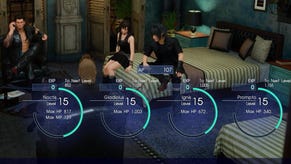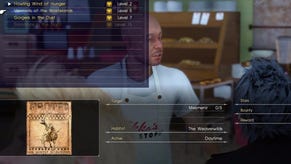Performance Analysis: Final Fantasy 15
A phenomenal optimisation effort from Square-Enix, but additional polish is required on PS4 and Pro.
For a while there, Final Fantasy 15 performance was looking a touch dodgy. Seemingly prioritising visual accomplishments over a stable frame-rate, each of the title's early previews exhibited profound issues - and even the more recent Platinum demo, which introduced dynamic resolution scaling, still disappointed. The good news is that the release code's finishing touches include the required raft of optimisations required to sustain 30fps. The bad news is that a key issue remains unresolved on PlayStation 4 hardware - one that Square-Enix really needs to address.
We're referring to incorrect frame-pacing. At the risk of turning this into a lecture, there's a reason why visually complex games lock to 30fps instead of matching your typical display's standard 60Hz - developers have twice the amount of render time available, and by presenting a new frame on every other refresh, you still get a smooth, consistent experience. Bad console frame-pacing typically sees developers put the required 30fps cap in place, but do not update the new frame on every other display update.
The end result is that you get a jittery presentation that actually looks like a lower frame-rate presentation. Frames should arrive paced at clean 33ms intervals, but instead they persist for 16ms, 33ms or even 50ms. In a third person title like Final Fantasy 15, which has a lot of sweeping camera movement, the perceived judder is difficult to ignore. However, here's the thing - Xbox One is completely unaffected, and there is a mode unique to the PS4 Pro version that also seems to mostly address the problem.
Let's discuss the Microsoft console version first. There's a dynamic resolution scaling solution in place that gives the title a softer look than its siblings, and in effects-heavy scenes, there are also performance dips you won't see on PlayStation hardware. Square-Enix has realised that this may be an issue, so it has implemented a semi-adaptive v-sync. If a frame is just a few milliseconds late for the next display refresh, the framebuffer flips a little later, resulting in a tear that is only ever seen at the top of the screen. But otherwise, frame-times are an absolutely rock-solid 33ms - a new frame is presented on every other display refresh. It's 30fps the way it's meant to be seen and it feels smooth and consistent.
PlayStation 4 Pro's 'lite' display mode almost on par with the consistency of the Xbox One presentation. The lite mode runs the base PS4 visual feature set at 1080p30 and features a rock-solid performance profile. Stutter in the form of incorrect frame-pacing is very rare during gameplay and is only really noticeable in the title's engine-driven cut-scenes. But switching to the higher resolution mode with its 1800p checkerboarding, improved texture filtering and shadows sees inconsistent frame delivery strike back with a vengeance. We've actually opted to play the game on lite mode instead - trading the resolution and improved image quality for a smoother experience. The good news is that HDR support - which is phenomenal in this title, by the way - works across all modes.
All of which leaves the base PlayStation 4 - the most important platform in terms of the size of its potential audience - right at the bottom of the pack. There is no way to avoid the stutter, it's an ever-present 'feature'. Now, it may well be the case that this kind of jitter isn't really an issue. The extent to which it is noticeable is seemingly quite a personal thing - but if you found it distracting in Bloodborne or Dark Souls 3, we found it to be much more intrusive here.
We will stress that this individual issue should be put into context of the wider achievement present here - something we'll be exploring in more depth soon. Square-Enix has crafted a beautifully epic open world game that looks beautiful, with a refined, elegant style that stands apart from anything else on the market. There are genuinely awe-inspiring moments here, like the first time you set foot in Lestallum City. In an age where it's rare to see actual 'poor' graphics in a top-tier video game, it really takes something phenomenal to impress us so deeply when the general standard is so high. But in this respect, Final Fantasy 15 is delivering and we barely feel like we've scratched the surface of the title so far.
But at the same time, in using the 'lite' mode on the PlayStation 4 Pro, we're effectively compromising on visual quality simply in order to correct an oversight that really should have been spotted a lot earlier. Going back to earlier Final Fantasy 15 demos, all the way back to Episode Duscae, it's clear that this issue has been present on PlayStation hardware (and not on Xbox One) throughout the game's development. It's just that performance overall was so poor on prior code that the issue wasn't so noticeable. Square-Enix has optimised this title to a degree we didn't think possible without nerfing visual features, but we feel that the frame-pacing issue really needs to be addressed.
We know that the developer is far from finished with the title - PlayStation 4 is set to receive further upgrades, for example, with the team shooting for a 1080p60 mode. So with that in mind, we hope that the relatively simple matter of fixing incorrect frame delivery makes it onto Square-Enix's to-do list. It's not like there isn't precedent here - the likes of Need for Speed Rivals, Destiny and most recently Mafia 3 have all received frame-pacing fixes in the wake of Digital Foundry coverage. It's the final visual flourish required to make a beautiful game look that much smoother.











